S&P 500 Climbs As Jobs Spur ‘Heat Check’ for Bonds: Markets Wrap
Track the global equity, currency and commodity markets here.

(Bloomberg) -- A pair of solid economic readings shook markets on Friday, with stocks rebounding on speculation the US will be able to skirt a recession. Now the flip side to that story is that bond traders were forced to trim their bets on rate cuts in 2024 — sending yields soaring.
All around Wall Street, the prevailing view is: While economic strength makes many investors less apprehensive about a hard landing, it also implies the Federal Reserve might have to hold rates higher for longer. For Treasuries, that means an unwinding of the massive dovish trade that pointed to a Fed pivot as early as March. For equities, jobs and consumer resilience bodes well when it comes to Corporate America.
“Just when you think the economy is finally softening, it continues to show signs of strength,” said Chris Zaccarelli at Independent Advisor Alliance. “We remain bullish on the market because we are bullish on the economy.”
Following a slew of figures underscoring a labor-market slowdown, Friday’s jobs report showed unexpected strengthening. Nonfarm payrolls increased 199,000 last month, the unemployment rate fell to 3.7% and monthly wage growth topped estimates. Meantime, US consumer sentiment rebounded sharply in early December — topping all forecasts — as households dialed back their year-ahead inflation expectations by the most in 22 years.
The S&P 500 saw its sixth straight week of gains — its longest winning run since November 2019. Wall Street’s “fear gauge” — the VIX — came back to pre-pandemic levels. US two-year yields jumped 13 basis points to 4.72%. Swap contracts now show a 40% probability of a March rate cut — from over 50% prior to the economic data.
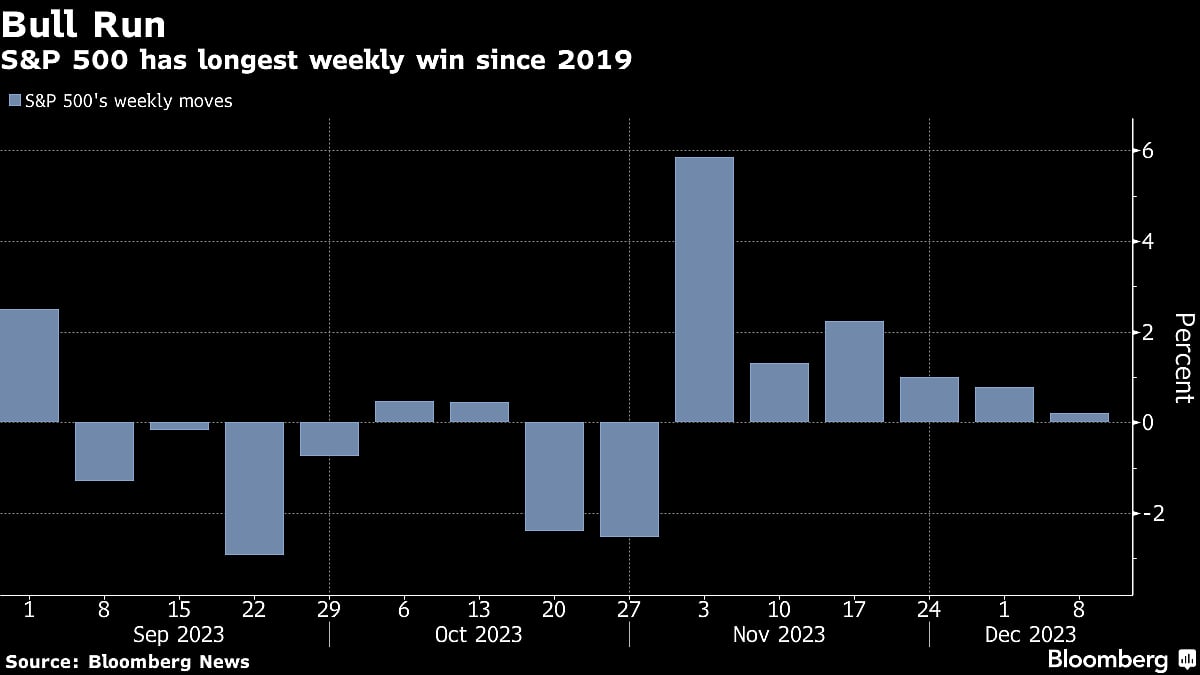
To Callie Cox at eToro, the strong jobs data could be a “heat check for Wall Street” after markets rallied significantly on the rate-cut trade. Hopes have gone a little too far, she noted.
“The US economy continues to perform well,” said John Leiper at Titan Asset Management. “The aggressive decline in US Treasury yields we saw last month, which already looked a little overdone, is going into reverse with bond yields jumping. With markets pricing out rate cuts next year, higher-for-longer is back in vogue.”
Softening inflation and employment data in the past month have convinced investors that the Fed is done raising interest rates and ignited bets that cuts of at least 125 basis points of cuts were in store over the next 12 months. Traders scaled back those wagers to about 110 basis points of easing.
“People saying recession need to have their heads examined,” said Neil Dutta at Renaissance Macro Research.
Traders are preparing for another busy week, with readings for the US consumer price index and retail sales, a compressed schedule of Treasury auctions — and the Fed’s final meeting of the year on the docket.
Fed officials are widely expected to keep borrowing costs at the highest level in two decades on Wednesday. Chair Jerome Powell has repeatedly pushed back against growing bets of rate cuts early next year, stressing that policymakers will move cautiously — but retain the option to hike again.
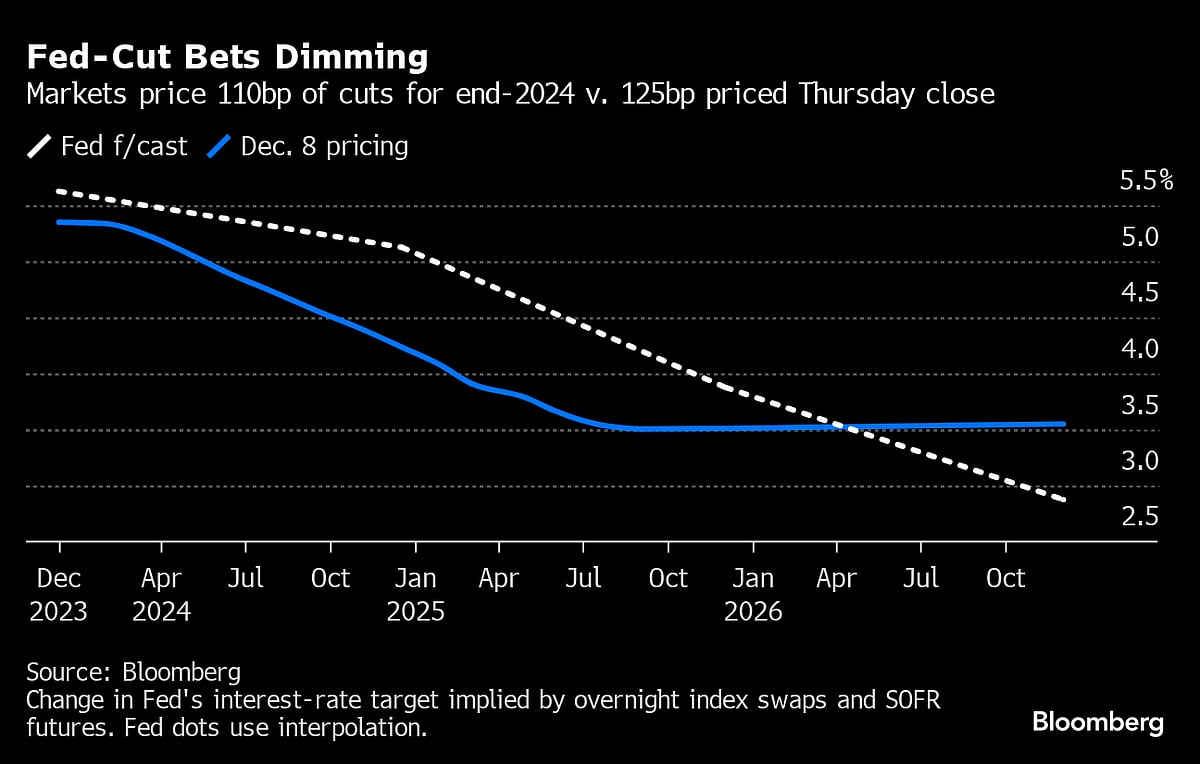
“The Fed has been stymied by better-than-expected data releases,” said Quincy Krosby at LPL Financial. “As long as inflation continues to edge lower, the Fed will likely remain on hold. But if today’s report is a harbinger of continued consumer spending, the Fed may have to issue a considerably more hawkish message and telegraph that they still cannot declare victory on their campaign to quell inflation.”
Former Treasury Secretary Lawrence Summers said the Fed should hold off on a shift toward lowering interest rates until there’s decisive evidence showing that inflation is back under control or that the economy is entering a slump.
To Brian Rose at UBS, given that the market is already pricing in a lot of rate cuts in 2024, the Fed will possibly avoid sounding “overly dovish.”
The Fed is likely to keep policy restrictive until mid-2024 — at which point inflation should have subsided sufficiently to warrant a modest easing cycle, according to Ronald Temple at Lazard.
“While labor market strength implies fewer rate cuts, investors should applaud the report as it suggests the Fed is delivering a ‘goldilocks’ scenario of lower inflation without recession — which is the best outcome for risk assets,” he noted.
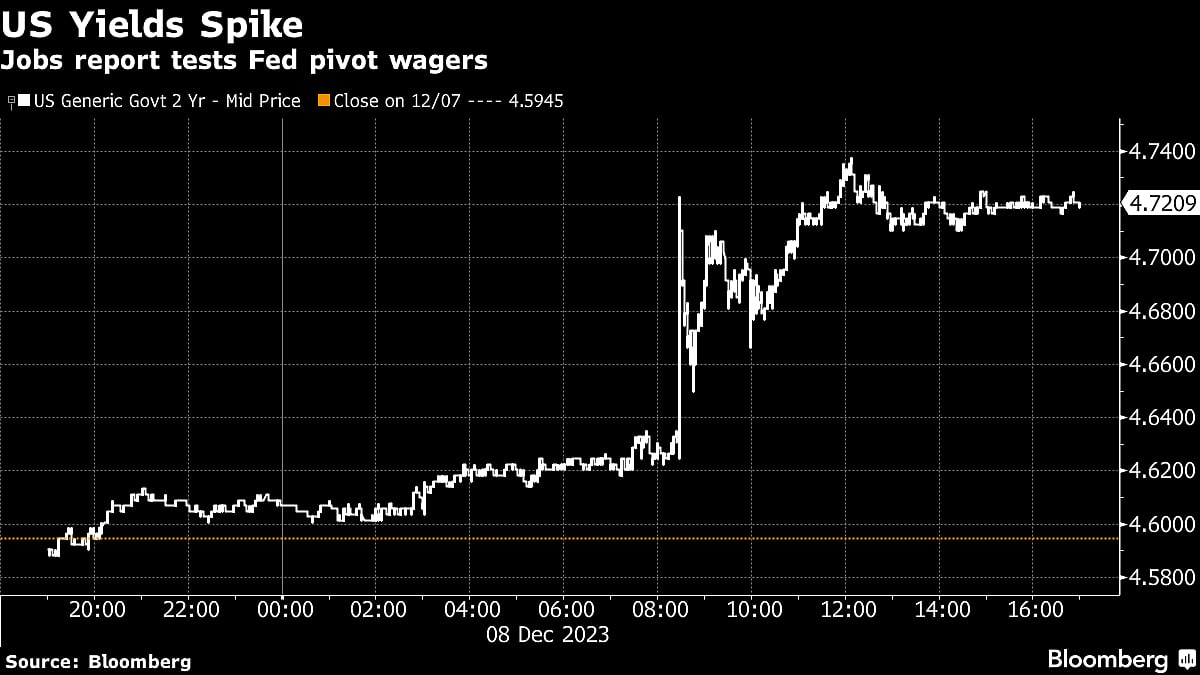
A key gauge of stock-market worry will climb in 2024 after tumbling to the lowest since before the pandemic struck — and the magnitude depends on the strength of the economy, according to JPMorgan Chase & Co. strategists.
The Cboe Volatility Index will “generally trade higher in 2024 than in 2023, and the extent of the increase depends on the timing and severity of an eventual recession” and potential wider swings that could curb selling of short-term volatility, the bank’s Americas equity derivatives strategists, led by Bram Kaplan, wrote in a note Friday.
Stock markets will suffer in the first quarter of 2024 as a rally in bonds would signal sputtering economic growth, according to Bank of America Corp.’s Michael Hartnett.
The narrative of “lower yields = higher stocks” would flip to “lower yields = lower stocks,” Hartnett wrote.
Sentiment indicators are also no longer supportive of further gains in risk assets, Hartnett said. BofA’s custom bull-and-bear signal surged to 3.8 from 2.7 in the week through Dec. 6, its biggest weekly jump since February 2012. A reading below 2 is generally considered to be a contrarian buy signal.
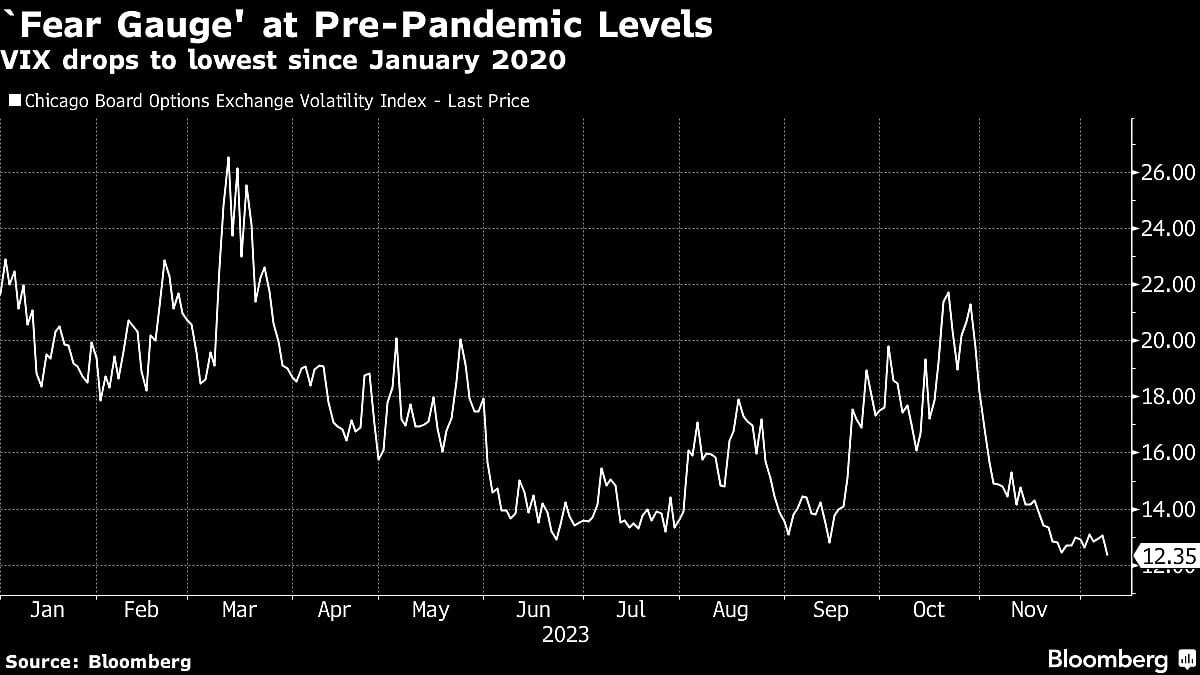
Money-market funds attracted their largest inflows since March, while US equities had an eighth straight week of inflows, BofA said, citing EPFR Global data.
David Bailin, Citi Global Wealth’s chief investment officer and head of investments, says stocks are ripe for further gains in 2024 as inflation trends lower, the economy remains resilient and earnings rebound — increasing the opportunity cost for investors still sitting on the sidelines, clinging to their cash.
“I’m not sure what investors are waiting for,” he said. “The US economy is going to stay strong and, eventually, money-market rates are going to come down, so why are people not buying core 60/40 portfolios?”
Elsewhere, oil bounced back on a stronger-than-expected US jobs report and plans to refill the Strategic Petroleum Reserve on Friday, but still closed out the longest weekly losing streak since late 2018 amid concern about an impending global glut.
Corporate Highlights:
- The Apple Inc. executive in charge of product design for the iPhone and smartwatch is stepping down, bringing a shake-up to the company’s most critical product lines.
- Honeywell International Inc. agreed to acquire the security business of Carrier Global Corp. for an enterprise value of about $5 billion, which marks the biggest deal since 2015 for the maker of jet engines and gas detectors.
- Starbucks Corp. said it reached out to the union representing hundreds of its stores, a potential step toward ending an impasse that has frayed the coffee giant’s relationship with some of its frontline employees.
- Alphabet Inc.’s Google said that the European Union’s threat to break up its profitable ad tech arm was “flawed” as it formally took aim at the bloc’s allegations of anticompetitive conduct.
- Microsoft Corp. and OpenAI Inc.’s partnership, which recently went through a governance meltdown, is facing yet more scrutiny after the UK antitrust watchdog said it’s considering if it should be called in for a full blown investigation.
- Anglo American Plc unveiled plans to drastically cut production in a bid to reduce costs amid logistical and operational snarls.
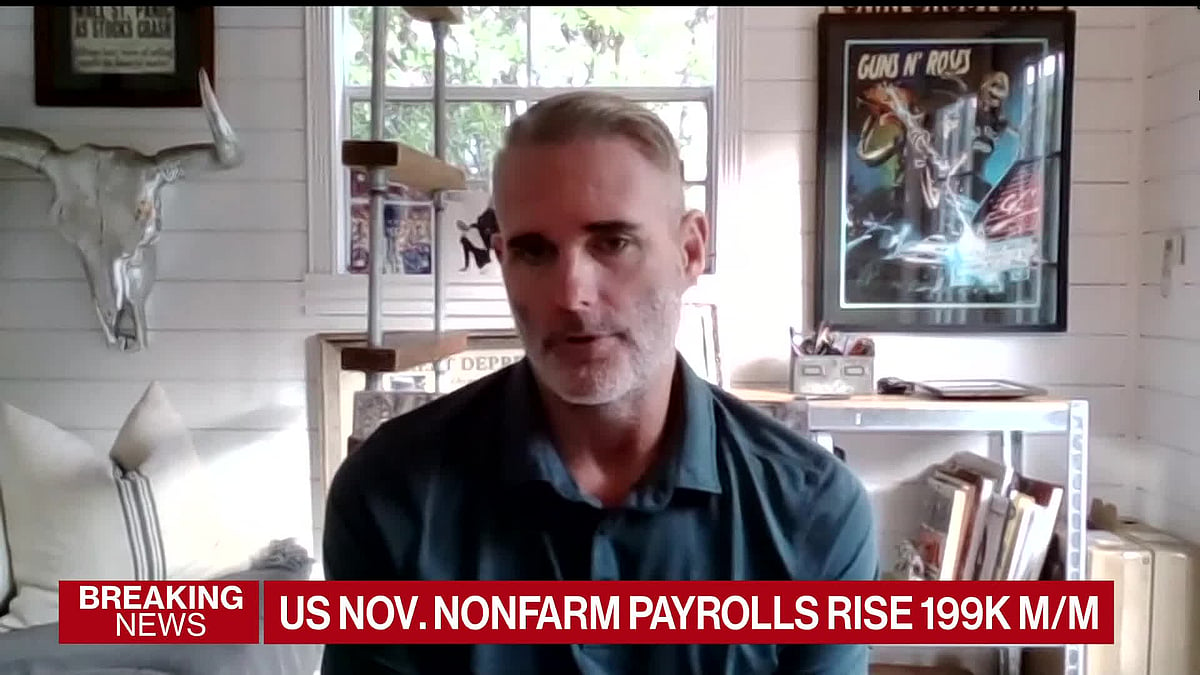
Some of the main moves in markets:
Stocks
- The S&P 500 rose 0.4% as of 4 p.m. New York time
- The Nasdaq 100 rose 0.4%
- The Dow Jones Industrial Average rose 0.4%
- The MSCI World index rose 0.3%
Currencies
- The Bloomberg Dollar Spot Index rose 0.2%
- The euro fell 0.3% to $1.0764
- The British pound fell 0.4% to $1.2548
- The Japanese yen fell 0.6% to 144.99 per dollar
Cryptocurrencies
- Bitcoin rose 2.3% to $44,379.44
- Ether fell 0.2% to $2,364.96
Bonds
- The yield on 10-year Treasuries advanced eight basis points to 4.23%
- Germany’s 10-year yield advanced nine basis points to 2.28%
- Britain’s 10-year yield advanced seven basis points to 4.04%
Commodities
- West Texas Intermediate crude rose 2.7% to $71.20 a barrel
- Spot gold fell 1.3% to $2,002.83 an ounce
This story was produced with the assistance of Bloomberg Automation.
--With assistance from Edward Bolingbroke, Sagarika Jaisinghani, Michael Mackenzie and Carly Wanna.
More stories like this are available on bloomberg.com
©2023 Bloomberg L.P.